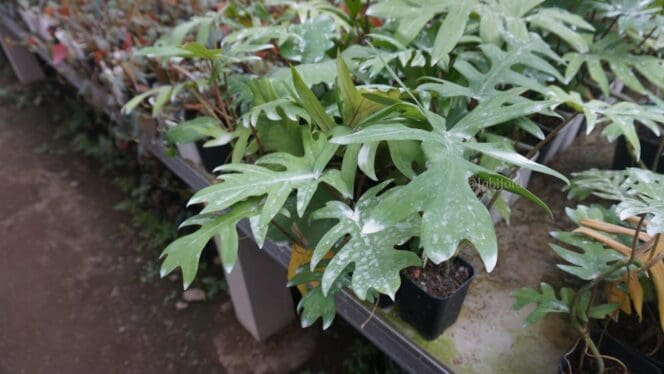Many people though how to taking care Philodendron Mayoi. How easy it’s?
It has always been a dream of mine to be calmed by the green corner inside my house when I return home from the outdoors. Philodendron Mayoi is one of my must-have plants that can meet all of my expectations. This gem plant is not only beautiful to look at, but it also requires low maintenance Philodendron.
Isn’t that ideal? So, let me tell you more about this philosophy, and you will have no regrets about having one, or more.
My attention was drawn to its palm-like leaves, which are rich in green and have a glossy appearance. As a distinctive feature of this philo, you will notice four or six deeply lobed leaves on each side. Also, because it is a climber plant, prepare additional equipment such as a pole or stake for it to climb on if you intend to have one. As a result of my actions, I can now see my Philodendron climbing high on the corner of my house.
On this post you can learn how to taking care philodendron mayoi on this post.
Light
It is preferable to think about the best location for this in order to have a healthy and well-grown Philodendron Mayoi because it affects light consumption, which is an important part of supporting its growth.Even though Mayoi tolerates low lighting, I recommend placing it in indirect bright sunlight. It is acceptable to expose it to direct sunlight on occasion, but you must avoid its intensity-or, to be safe, do it in the morning or late evening. If you notice a yellowish color on the surface of the leaves or sunburn spots, it means your Mayoi is getting too much light.
Furthermore, if you place this indoors, as I do, you must consider ventilation because it requires good circulation. As a result, I placed it near the window. As a result, my Mayoi receives indirect sunlight and is well circulated. Also, rotate the pot frequently to ensure that all of the leaf surfaces receive equal sunlight and can perform photosynthesis effectively.
If it grows in a place where there isn’t enough natural light, you’ll need to give it artificial light because that’s the best way to keep it alive.
Water
Aside from thinking about its light requirements, I have learned to care for Mayoi by witnessing its water consumption requirements. One thing to keep in mind is that Mayoi does not like wet soil because the roots rot quickly. I always drain the water after watering to avoid this. Also, depending on the weather, I only need to water it about twice a week. When I see the soil on the surface is dry, I check the inside with a chopstick to see how wet it is. I water it after it has completely dried. Remember that Mayoi despises overwatering, so be cautious.
Because Mayoi despises overwatering, the growing media plays an important role in promoting its growth. To avoid wet and rot, choose a well-drained, loose soil. Another factor to consider is that the soil should be rich in organic matter. A mixture of soil, cocopeat, vermicompost, and a small amount of charcoal chips and perlite can be used.
As I’ve discovered, despite its origins in tropical areas, Mayoi can thrive in warm temperatures. It can withstand temperatures ranging from 24–270C (75–800F) or lower, starting at 180C (650F). This type of condition should be maintained from day to night so that it does not remain in a location where the temperature can suddenly drop when night falls. If you live in the winter, keep it away from temperatures below 130 degrees Celsius because it will die.
Humidity
I always keep my Mayoi at a high humidity level at home because that is what its origin provides. Fortunately, it is supported by my tropical environment. If you do this, your leaves will grow larger and healthier. A low humidity room does not necessarily result in a dying plant, but the leaves may become smaller. If your home can’t provide this level of humidity, don’t worry; you can always use a humidifier to make up for it.
Propagation

Actually, if you already have one Mayoi, you don’t need to buy another. Because it grows well and is healthy, I am learning how to propagate it on my own. It’s actually a piece of cake! All I have to do now is select the mature part, cut under the nodes, and place it in the pot with soil. By doing so, I simply treat it as if it were an afterthought. Another time, I placed it in the jar of water and allowed all of the nodes to soak. When I see a new shoot emerge, I can move it to a suitable location using a soil mixture.
Fertilizer
Fertilizing Philo Mayoi is preferred and advised to grow large and healthy. Several things to consider before selecting the best fertilizer include the best time to feed it, especially given that it is a low-light plant that does not require a lot of fertilization.
Regular feeding can be done while watering Philo by mixing it with a small amount of nitrogen-rich fertilizer. In the summer, you can supplement your plants with natural fertilizers such as coffee grounds or dried tea leaves.
Other Suggestions
To keep problems away from Philodendron mayoi, I perform regular checks to ensure that my plant receives adequate nutrition. The first thing I always make certain of is that it drains the soil after watering. In a similar vein, I frequently inspect the inside of soil to prevent it from flooding.
We also have another rare philodendron that can be shipped to your doorstep effortless with affordable price
